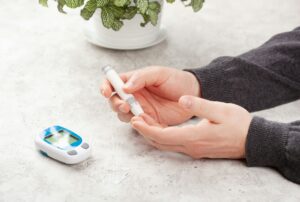Diabetes management is a complex and often overwhelming task that requires constant monitoring, dedication, and a deep understanding of one’s body and condition. David, a 45-year-old accountant diagnosed with Type 1 diabetes at the age of 25, has navigated the challenges of this chronic illness for two decades. Over the years, he has leveraged technological advancements to improve his diabetes management significantly. This blog post delves into David’s journey and highlights the tools and strategies he adopted to gain better control over his health.
Early Challenges and Traditional Management
In the early years following his diagnosis, David relied on traditional methods for diabetes management, which primarily included the use of manual blood glucose meters and insulin injections. Like many diabetics, David faced numerous obstacles, such as frequent blood sugar fluctuations and the constant risk of hypoglycemia or hyperglycemia. The unpredictability of his blood glucose levels often left him feeling apprehensive and constrained in his daily activities.
Manual blood glucose monitoring, while effective to some extent, posed significant challenges. Test strips and lancets were cumbersome, and the need for frequent finger pricks was both painful and inconvenient. The inability to obtain real-time data on blood sugar levels often meant that David was reacting to problems after they occurred, rather than proactively managing his condition.
Embracing Continuous Glucose Monitoring (CGM)
The introduction of Continuous Glucose Monitoring (CGM) systems revolutionized the way David managed his diabetes. CGM devices provide real-time data on glucose levels, displaying trends and patterns that were previously hidden. With the aid of a small sensor inserted under the skin, the CGM device continuously measures glucose levels in interstitial fluid and sends data to a receiver or smartphone app.
For David, the benefits were immediate and profound. He could now track his blood glucose levels throughout the day and night, receiving alerts for critical highs and lows. The ability to visualize glucose trends enabled him to fine-tune his diet, exercise, and insulin regimen more effectively. Moreover, the reduced need for finger pricking improved his quality of life significantly.
One of the key features that David appreciated was the ability to share his CGM data with his healthcare team. This collaborative approach allowed for more informed and tailored medical advice during consultations, leading to better overall management of his condition.
Insulin Pumps and Smart Pens
Another technological leap in David’s journey was the adoption of an insulin pump. Insulin pumps are sophisticated devices that deliver rapid-acting insulin throughout the day via a catheter placed under the skin. These devices closely mimic the body’s natural insulin delivery and provide more precise control over blood sugar levels.
David’s transition to an insulin pump was transformative. The pump’s programmable settings allowed him to customize basal and bolus rates according to his specific needs, reducing the chances of both hyperglycemia and hypoglycemia. The freedom from multiple daily injections offered greater flexibility in meal planning and physical activities.
Recently, David also explored the use of smart insulin pens. These pens are compatible with mobile apps that track insulin doses, timing, and other critical parameters. Smart pens serve as an excellent alternative for those who prefer not to use pumps but still want the benefits of digital tracking and dose calculation. David found the smart pen’s dose reminders and missed-dose alerts particularly helpful in maintaining his regimen.
Mobile Apps and Data Analytics
David’s approach to diabetes management is further enhanced by a suite of mobile apps designed to monitor and analyze health data. Apps such as MySugr, Glucose Buddy, and Glooko provide comprehensive platforms for tracking blood glucose, nutrition, physical activity, and medication. These apps often integrate seamlessly with CGM devices and insulin pumps, creating a centralized hub for all diabetes-related information.
Data analytics play a crucial role in identifying patterns and making informed decisions. For David, the insights gained from these apps allowed him to understand how different foods, exercises, and stress levels affected his blood glucose. Customizable reports and visual graphs enabled him to spot trends that were not immediately apparent, facilitating more precise adjustments to his management plan.
Additionally, David leveraged the power of artificial intelligence with apps like BlueLoop and Hedia, which use algorithms to provide predictive analytics and suggestions. These AI-driven tools offered personalized recommendations to help him maintain optimal glucose levels, further empowering him to stay ahead of potential issues.
Telemedicine and Remote Monitoring
The advent of telemedicine has had a significant impact on David’s diabetes management, especially during times when in-person visits to healthcare providers were challenging. Virtual consultations with his endocrinologist allowed David to maintain regular check-ins and fine-tune his treatment plan without the need for physical appointments.
Remote monitoring technologies also facilitated continuous oversight of David’s condition by his healthcare team. Devices capable of transmitting real-time data to medical professionals ensured that any concerning trends were quickly addressed. Integrated platforms enabled seamless communication and data sharing, promoting a collaborative care model that was both proactive and responsive.
Wearable Technology and Fitness Trackers
Wearable technology, such as fitness trackers and smartwatches, has further contributed to David’s holistic approach to diabetes management. Devices like Fitbit and Apple Watch monitor physical activity, heart rate, and sleep patterns, providing additional layers of data that are crucial for managing diabetes.
David used these devices to track his daily steps, exercise routines, and overall activity levels. By correlating this information with his blood glucose data, he could optimize his physical activity to maintain stable glucose levels. The ability to set goals and receive reminders also helped him stay motivated and consistent in his exercise regimen.
Sleep quality is an often-overlooked aspect of diabetes management, and wearable technology provided David with valuable insights into his sleep patterns. Poor sleep can affect insulin sensitivity and glucose metabolism, making it essential to address sleep-related issues. By monitoring and improving his sleep quality, David observed better overall glucose control and enhanced well-being.
The Social and Emotional Aspect of Technology
Beyond the practical benefits, technology also played a significant role in addressing the social and emotional aspects of David’s diabetes journey. Online communities and social media platforms offered support, education, and camaraderie from fellow diabetics. Engaging with these communities provided David with a sense of belonging and a wealth of shared experiences and advice.
Psychologically, the empowerment and control afforded by technology reduced the anxiety and stress associated with diabetes management. David found himself more confident in his ability to handle the demands of his condition, leading to an overall improvement in his mental health.
Conclusion
David’s path to improved diabetes management through technology showcases the transformative power of modern tools and innovations. From Continuous Glucose Monitoring (CGM) systems to insulin pumps, smart pens, mobile apps, telemedicine, and wearable devices, each technological advancement has contributed to a more proactive, informed, and effective approach to managing diabetes.
While challenges remain, the integration of technology has provided David with a comprehensive and personalized strategy for maintaining optimal glucose levels and enhancing his quality of life. For many individuals living with diabetes, embracing these advancements may hold the key to better health outcomes and a more fulfilling life. David’s journey serves as an inspiring testament to the potential of technology in revolutionizing diabetes care and management.




